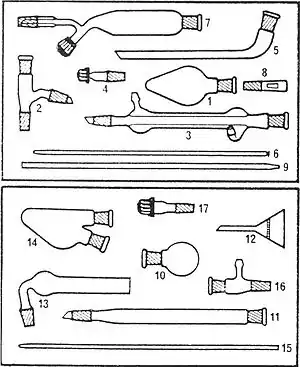
Quickfit is a brand of laboratory glassware, produced under the Pyrex trademark and distributed through various fronts in differing countries; e.g. Corning in North America. The glassware is well known worldwide for its build quality and it appears in numerous laboratories. A large percentage of the glassware makes use of ground glass joints.
The Quickfit brand is blown in Stone, Staffordshire, in the United Kingdom and marketed through DWK in the United Kingdom. 'Quickfit' has become a genericized trademark for all ground glass. Whilst the ownership and name of Quickfit has changed numerous times, all genuine Quickfit glass is stamped with a Q, displaying the brand name, the word Pyrex and the part code.
Timeline
1923, James A. Jobling licensed to produce Pyrex branded glassware[1]
1962, Quartz and Quickfit glassware goes into production at Stone[1]
1970, Quickfit becomes a part of Jobling Lab Division[1]
1973, Quickfit joins the Corning company[1]
1982, Corning Laboratory Division becomes J.Bibby Science Products[1]
1986, J Bibby Scientific Products becomes Bibby Sterilin[1]
2005, Bibby Sterilin becomes Barloworld Scientific[1]
2008, SciLabware is introduced[1]
2011, Scilabware becomes part of the Duran Group
2015, Duran Group acquires & integrates WHEATON Industries Inc
2016, UK entities of WHEATON & SciLabware consolidate into new SciLabware
2017, Launch of DWK Life Sciences, SciLabware launches new branding
2020, SciLabware Ltd becomes DWK Life Sciences Limited